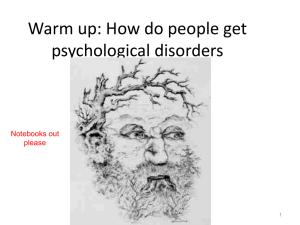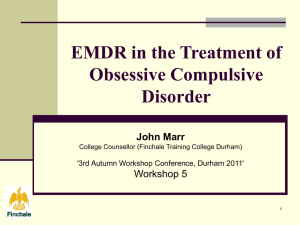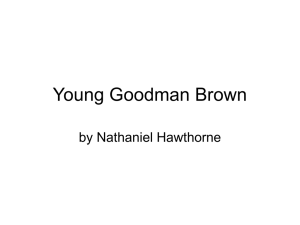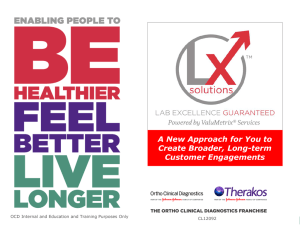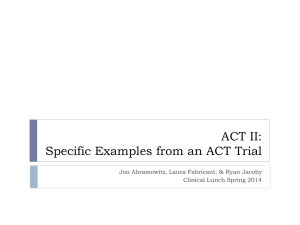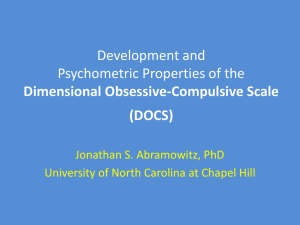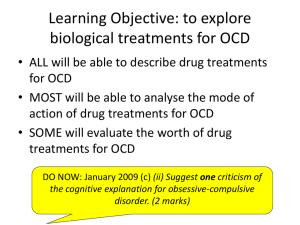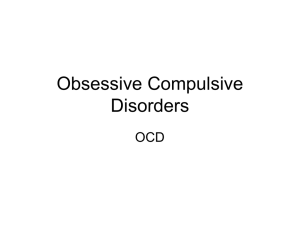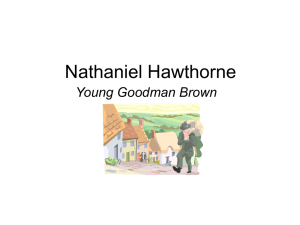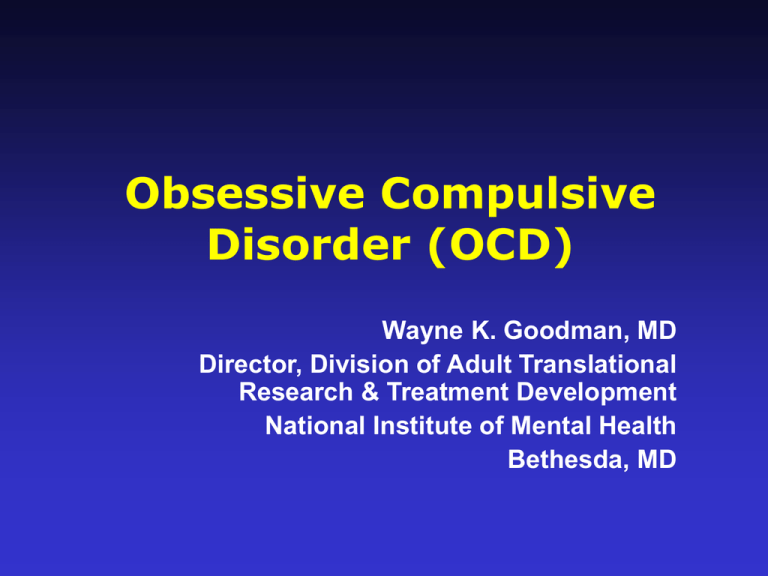
Obsessive Compulsive
Disorder (OCD)
Wayne K. Goodman, MD
Director, Division of Adult Translational
Research & Treatment Development
National Institute of Mental Health
Bethesda, MD
Learning Objectives
• To reliably diagnose OCD and differentiate
it from other anxiety disorders
• To learn the basis for the theories of
pathophysiology of OCD
• To learn the evidence for a rationale
approach to the treatment of OCD
WK Goodman
Outline
• Nosology, Phenomenology & Differential
Diagnosis
• Demographics, Prevalence and Course
• Putative Subtypes
• Pathophysiology
– Serotonin and neurochemical hypotheses
– Neuroanatomical circuits
– Pathogen-triggered autoimmune-mediated theory
WK Goodman
Outline (cont’d) of Treatment
• Behavioral therapy
• Pharmacotherapy basics
– Preferential efficacy of SRIs
– Measuring change
• Approaches to treatment-resistant OCD
– Augmentation strategies (e.g., adding antipsychotics)
– Novel biological interventions (e.g., deep brain
stimulation)
WK Goodman
Question #1
Which may be a manifestation of OCD?
a. distorted belief of being fat and counting
calorie intake not to exceed 1000 per day
b. can’t get ex-girlfriend out of his mind and feels
compelled to know her whereabouts
c. recognizes irrationality of need to check
envelopes to ensure 5-year old daughter is not
inside
d. compulsively eats everything in front of him
and feels guilty afterwards
WK Goodman
Question #2
The serotonin hypothesis of OCD is
a. supported by PET imaging studies
b. no longer consistent with treatment
studies
c. based primarily on preferential
response of SRIs
d. confirmed by post-mortem data
WK Goodman
Question #3
The brain regions implicated in OCD are
a. orbito-frontal cortex and basal ganglia
b. amygdala and cerebellum
c. hippocampus and locus ceruleus
d. unknown
WK Goodman
Question #4
Evidenced based treatments for OCD
include
a. SSRIs and buspirone
b. SSRIs, SNRIs and alprazolam
c. SSRIs, clomipramine and CBT
d. SSRIs and ECT
WK Goodman
Question #5
Use of antipsychotics in OCD is
a. inappropriate because these patients
are not psychotic
b. confined to augmentation of SRIs in
refractory cases
c. an option as either monotherapy or
adjunctive treatment
d. only effective for suppressing tics
WK Goodman
Obsessive Compulsive
Disorder (OCD)
• Classified as anxiety disorder in DSM-IV.
• Recurrent unwanted and distressing thoughts
(obsessions) and/or repetitive irresistible behaviors
(compulsions).
• Majority have both obsessions and compulsions.
• Insight present: acknowledged as senseless or
excessive at some point during illness.
• Compulsions usually reduce anxiety but are not
pleasurable.
• Symptoms produce subjective distress, are timeconsuming (>1hr/day), or interfere with function.
WK Goodman
Obsessions
• Recurrent and disturbing thoughts,
impulses, or images
• Experienced as intrusive (ego-dystonic)
• Not just excessive worries about real-life
events such as in GAD
WK Goodman
Obsessions
• Attempts are made to ignore, suppress or
neutralize the thoughts with some other
thought or action (a compulsion)
• Person knows it’s his/her own thoughts
WK Goodman
Common Obsessions
• Typical concerns include:
contamination
aggression
safety/harm
sex
religion (scrupulosity)
somatic fears
need for symmetry or exactness
n
n
n
n
n
n
n
WK Goodman
Compulsions Defined
• Repetitive behaviors or mental acts the person
feels driven to perform either
– In response to an obsession, OR
– According to rigid rules
• Designed to prevent or reduce distress or to
prevent some dreaded event from occurring
• The acts are clearly excessive or senseless
WK Goodman
Common Compulsions
• Typical behaviors include:
cleaning/washing
checking
ordering/arranging
counting
repeating
hoarding/collecting
n
n
n
n
n
n
WK Goodman
Differentiating Tics From
Compulsions
• Tics
n
n
Involuntary, sudden, rapid, recurrent,
nonrhythmic, stereotyped motor movement or
vocalization
Experienced as irresistible, but can be suppressed
to some degree
• Compulsions
n
Repetitive and seemingly purposeful behaviors
that the person feels driven to perform, usually,
but not always, in response to an obsession
WK Goodman
Differentiating Tics From
Compulsions
• Complex motor tics
Facial gestures, grooming behaviors,
jumping, touching, stamping, and
smelling an object
• Tic-like compulsions
Touching, tapping, rubbing, stereotyped
repeating of routine activities , and
“evening-up” behaviors
n
n
WK Goodman
Holzer, Goodman, McDougle, 1994; Cath et al., 2001.
Symptom Continuum
Fears
Anxiety
Harm
Avoidance
O
B
S
E
S
S
I
O Intrusive Ideas
N
S
Tension
reduction
“just right”
Risk-taking
C
O
M
P
U
L
S
Sensory Triggers
I
Unwanted Impulses O
Tics
N
S
Identifying OCD
• Patients reluctant to disclose their unwanted thoughts and
odd behaviors
• Think of OCD in patients presenting with depression or
anxiety
• OCD Screening Question
– Sometimes people will be bothered by unwanted or repetitive
thoughts or sudden, strong urges to check, wash, or count
things. Does anything like that ever happen to you?
WK Goodman
OCD: Prevalence & Course
•
•
•
•
Lifetime prevalence = 2 - 3%
Childhood Onset > 50%
Chronic, sometimes disabling
Men and women equally affected.
WK Goodman
Brown Obsessive Compulsive Study:
Age at Onset of OCD
35
30
Number
of
Patients
Male
Female
25
20
N = 250
15
10
5
0
6-9
10-12
13-15
16-19
20-24
25-29
Age at Onset
Rasmussen et al. J Clin Psychiatry 51(suppl 8):20, 1990
WK Goodman
Summary: Recognition &
Course
• OCD is common, typically chronic and can
be disabling
• Some cases in childhood follow an
episodic course
• Patients may camouflage their symptoms
out of embarrassment
• Probe for OCD in patients presenting with
depression or another anxiety disorder
WK Goodman
Comparison of Childhoodvs. Adult-Onset OCD
• About 50% of OCD has onset 18 years or
younger
• Higher incidence of co-morbid tics
• Higher rate of first degree relatives with tic
disorder or OCD (i.e., childhood onset more
likely to be familial)
• “Insight” not required to make diagnosis in
children
WK Goodman
Heterogeneity of OCD
• Putative Subtypes
– Symptom Typology (e.g., hoarding)
– Comorbidity (e.g., Tourette’s Syndrome)
– Childhood Onset/Familial
– PANDAS*
– Traumatic (Acquired) – suspect in onset after
age 60 years (e.g., basal ganglia stroke)
*Pediatric Autoimmune Neuropsychiatric Disorder Associated with Strep
WK Goodman
Clinical Dimensions That May Represent
Different Subtypes of OCD
•
•
•
•
•
•
Fear of Harm
Aggressive or Other Unacceptable Urges
Incompleteness/”Just So”/Exactness
Disgust
Hoarding/Collecting
Tic-like Phenomena
WK Goodman
Summary: Subtypes of OCD
• Childhood onset OCD is more likely to be
associated with tics and to be familial
• Hoarding and Pathological Slowness clinical
subtypes may be more resistant to treatment
• OCD patients with tics are more likely to present
with OC symptoms involving symmetry,
exactness, touching and evening up and other
“tic-like” behaviors
WK Goodman
Pathogenesis of OCD
•
•
•
•
•
Psychoanalytic theories
Learning theory models
Serotonin hypothesis
Glutamatergic hypothesis
Basal Ganglia – Orbitofrontal Cortex
circuit
• Infection-triggered autoimmune process
WK Goodman
Approaches to Investigating
5HT Function in OCD
• Inferences from treatment response data
– Pharmacological dissection
– Augmentation trials
• Challenge studies using specific 5HT probes (e.g.,
tryptophan depletion)
• Biomarkers in periphery, CNS or brain (postmortem)
• Functional imaging (e.g., PET)
• Animal models
• Genetic studies
WK Goodman
Summary: Serotonin
Hypothesis
• The serotonin hypothesis is based on the preferential
efficacy of potent blockers of serotonin reuptake in OCD
• However, direct support for a role of serotonin in the
pathophysiology (e.g., biomarkers in pharmacological
challenge studies) of OCD is lacking
• Functional imaging studies (both fMRI and PET) show fairly
consistent evidence for increased brain activity in orbitfrontal cortex and caudate nucleus of patients with OCD
• Furthermore, these abnormalities normalize during
successful treatment of OC symptoms whether with SRIs or
CBT
WK Goodman
Evidence for Glutamatergic
Involvement in OCD
• Glutamine is excitatory neurotransmitter
in cortico-striato-thalamo-cortical circuit
• Increased caudate glutamate by MRS
(Rosenberg et al, JAACAP 2000)
• Elevated CSF glutamate (Chakrabarty et
al, Neuropsychopharm 2005 )
• Riluzole augmentation (Coric et al, Biol
Psych 2005)
WK Goodman
Rauch et al 1994
Evidence for Basal Ganglia
Involvement in OCD
•
•
•
•
•
Functional Neuroimaging
Accidents of Nature
Relationship to Tourette’s Syndrome
Results of Neurosurgery
Neuroethology Perspective
WK Goodman
Brain Regions Implicated in OCD
• Frontal Lobes (esp. orbito-frontal
cortex)
• Basal ganglia (esp. caudate & globus
pallidus)
WK Goodman
PET and fMRI Studies of OCD and
Other Anxiety States: Symptom
Provocation Paradigms
Regions Activated
Study
Dx
Modality
Caudate
Rauch
1994
McGuire
1994
Breiter
1996
Rauch
1995
Rauch
1996
Benkelfat
1995
A/LOFC Paralimbic
OCD
PET
Yes
Yes
Yes
OCD
PET
Yes
Yes
Yes
OCD
fMRI
Yes
Yes
Yes
Simple
Phobia
PTSD
PET
No
No
Yes
PET
No
No
Yes
Normal
PET
No
No
Yes
WK Goodman
PANDAS
Pediatric Autoimmune Neuropsychiatric
Disorders Associated with Streptococcus
• Dramatic childhood onset of OCD/tics
• Other neurological signs (eg, “choreiform”
movements)
• Evidence of strep infection associated
with onset or exacerbation of symptoms
• Episodic or Sawtooth course
Relationship Between OCD
and Sydenham’s Chorea
• Swedo et al proposed Sydenham chorea (SC) as a
medical model for childhood-onset OCD
• SC is a late manifestation of rheumatic fever (RF)
• RF is a complication of untreated group A hemolytic strepococcal (GAS) infection
• GAS infection triggers antineuronal antibodies
that cross-react with an epitope on basal ganglia
neurons
WK Goodman
Possible PANDAS
Treatments
•
•
•
•
Plasmapheresis
IV immunoglobulin
Prednisone
Penicillin Prophylaxis
WK Goodman
Clinical Implications of
PANDAS
• Consider Sydenham’s variant of OCD in
child with acute onset adventitous
movements, hypotonia, and behavioral
changes
• Obtain history and serology for recent strep
pharyngitis.
• Look for cardiac and other major
manifestations of RF
• Treatments under study include
antimicrobials or immunomodulatory
interventions
WK Goodman
Treatment of OCD
• Previously considered treatment resistant
• Insight-oriented therapy rarely helps core
symptoms
• Effective treatments:
Behavior therapy
(ie, exposure/response prevention)
Potent serotonin reuptake inhibitors
n
n
WK Goodman
Behavior Therapy for OCD
• Doesn’t concern itself with origins of
illness
• Attempts to change thinking and behavior
using practical techniques
• Technique used in OCD is called Exposure
and Response (Ritual) Prevention (ERP)
WK Goodman
Behavior Therapy for OCD
Reasons for Treatment Failure:
• Inadequate Trial (e.g., noncompliance, <
20hrs exposure)
• Severe depression
• Conviction that fear is realistic
• Mainly obsessions/few rituals
WK Goodman
Efficacy of SRIs in OCD
• Anti-OC efficacy established with:
clomipramine
fluvoxamine
fluoxetine
sertraline
paroxetine
citalopram/escitalopram (no FDA indication)
• SRIs preferentially effective compared to other
antidepressants (e.g., desipramine)
n
n
n
n
n
n
Efficacy of SRIs in OCD
• Response is usually graded and
incomplete
• 40 - 50% non-responders
• Among “responders”, improvement is
rarely complete
WK Goodman
SRIs in OCD
• Adequate trial is 10 to 12 weeks long
• Same or higher doses than used in
depression
• Start with selective SRI (SSRI)
• After 2 failed SSRI trials, prescribe
clomipramine
WK Goodman
Fluvoxamine vs.
Clomipramine (U.S. Trial)
Treatment Week
0
1
2
3
4
5
6
7
8
9
10
Baseline
-1
-2
Mean Change
in Y-BOCS
Scores
Clomipramine
Fluvoxamine
-3
-4
-5
-6
-7
(N = 39)
-8
(N = 34)
Koran et al, J Clin
Psychopharmacol 16:121, 1996
WK Goodman
Initial Sequence of Trials
SSRI#1
Combine:
•Antipsychotic
SSRI#2
•?
•?
Clomipramine
Novel Agents
Treatment-Resistant OCD
• Evaluate adequacy of trials
– Duration
– Dose
– Adherence
• Differentiate intolerance from lack of efficacy
• Different levels of treatment resistance
• Apply most stringent criteria before employing
experimental or invasive measures
WK Goodman
Defining Endpoints
• Response
– Change from baseline in acute trial
• Remission
– Magnitude of symptom severity is low
– No universally accepted definition in OCD
WK Goodman
Y-BOCS Scores and Clinical
Change
• Responder defined by 25% or greater
change in Y-BOCS from baseline.
• Some studies have used more stringent
criterion of 35%.
• Change of 25% and endpoint Y-BOCS
10, is in range of being remitted.
WK Goodman
Defining Remission in OCD
•
•
•
•
Total Y-BOCS 10
AND item 1 (time obsessions) not > 1
AND item 6 (time compulsions) not > 1
Subthreshold for DSM-IV diagnosis based
on time < 1 hour per day.
WK Goodman
Y-BOCS
Overview
• Intended as a specific measure of OCD
symptom severity in diagnosed patients.
• Score independent of type or number of
obsessions or compulsions.
• Divided into two parts:
– Symptom Checklist
– 10 Severity Questions
• Emphasizes process over content
WK Goodman
Y-BOCS Scores and Clinical
Severity
Score
Global
0-7
Subclinical
8-15
Mild
16-23
Moderate
24-31
Severe
32-40
Extreme
WK Goodman
Children’s Yale-Brown Obsessive
Compulsive Scale (CY-BOCS)
• Language simplified (e.g., “habits” instead
of “compulsions”)
• Symptom checklist modified (e.g.,
checking backpack for school books)
• Consistent use of informants
• Reliability and validity confirmed by
Scahill et al (JAACAP, 36: 844, 1997)
WK Goodman
Summary: Mainstays of
Treatment
• The two well-established evidence-based
treatments for OCD are serotonin reuptake
inhibitors and a form of CBT
• For the most part, the literature shows a
higher rate of response with CBT
• However, a number of patients do not
adhere to CBT and assess to qualified
therapists is limited
WK Goodman
Summary: Treatment of OCD
vs. Depression
• In general, antidepressant doses necessary for optimal
control of OCD are higher than those used in depression
• SSRIs are generally less effective in OCD than they are in
depression or panic disorder
• Even “responders” to SSRI treatment usually have residual
OC symptoms
• However, SSRIs are preferentially effective in OCD:
meaning that other classes of antidepressants (e.g., the NE
uptake inhibitor desipramine) are effective in depression
yet ineffective in OCD
• Another difference between treatment of OCD and
depression is that ECT, the gold standard for depression, is
ineffective in OCD
WK Goodman
Summary: SSRIs and
Clomipramine
• Initiate treatment with an SSRI for 10 -12 weeks at an
adequate dose
• There are no data to suggest one SSRI is superior to
another – selection should be based on side effect profile
• Early trials showed large effect size for clomipramine, but
more recent head-to-head trials with SSRIs show no
significant advantage for CMI
• CMI has more side effects than SSRIs
• Nevertheless, no OCD patient should be considered
medication resistant without a trial of clomipramine (CMI)
WK Goodman
Combination Treatments
Strategies
• Combining SRIs
• SRI plus other agents
serotonergic drugs
noradrenergic drugs
neuroleptics
others
• SRI plus behavior therapy
n
n
n
n
WK Goodman
Summary: Combining CBT and
SRIs
• Conventional wisdom suggests that a
combination of CBT and SRI is the best treatment
for OCD
• Surprisingly, some studies do not show an
advantage of combined therapy over
monotherapy alone
• CBT appears to have the largest effect size but its
usefulness is limited by non-adherence and
availability of trained therapists.
WK Goodman
Combining SRIs
• SSRI - SSRI combination
rationale unclear
• Clomipramine (CMI) plus SSRI:
to minimize or capitalize on side effect of
CMI
to enhance efficacy (assumes “something
special” about CMI)
WK Goodman
Combination Treatments
Adding serotonergic drugs
•
•
•
•
L-tryptophan: safety issues; limited trials
Fenfluramine: safety issues; no db trials
Buspirone: 3 negative db, pc trials
Lithium:
• negative db, pc trials
• may help comorbid depression
• Pindolol: does not appear effective in OCD unless
combined with L-tryptophan
db, double-blind; pc, placebo-controlled
WK Goodman
Neuroleptics in OCD
• Increasing number of positive reports
• Search for clinical predictors of response
– “Schizo”-obsessives
– “Delusional” OCD
– “Tic-spectrum” OCD
WK Goodman
Adding Neuroleptics to SRIs
in OCD
• Earlier studies suggested that conventional
neuroleptics preferentially benefit patients
with comorbid tic disorders
• More recent studies with atypical
antipsychotics suggest broader spectrum
of action
• Atypical neuroleptics have been associated
with induction of OC symptoms in
schizophrenic patients.
WK Goodman
Tourette’s Syndrome
• DSM-IV criteria:
Both multiple motor and one or more vocal
tics
Occur many times a day nearly everyday
for more than 1 year (no tic-free period of
>3 consecutive months)
Marked distress or significant impairment
Onset before age 18 years
n
n
n
n
WK Goodman
SRI + Risperidone in OCD
McDougle et al, 2000
36 SRI nonresponders
entered 6week doubleblind, placebocontrolled trial
N=20
N=16
Novel Drug Treatments
Worthy of Further Study
•
•
•
•
•
•
Tramadol
IV clomipramine or citalopram
Inositol
Rizulole
Plasmapheresis (for PANDAS)
Antimicrobial treatments (for PANDAS)
WK Goodman
Summary: Augmentation
• Consider augmentation in partial responders to
SSRIs
• Adjunctive antipsychotics (especially
risperidone) has the most support
• Although the evidence from controlled trials for
the efficacy of other augmentation approaches
(e.g., buspirone) is negative or limited, individual
patients may benefit – there is always something
else worth trying
WK Goodman
Non-Pharmacological
Biological Treatments
• Electroconvulsive therapy (ECT)
• Repetitive Transcranial Magnetic
Stimulation (rTMS)
• Vagus Nerve Stimulation (VNS)
• Neurosurgery
– Ablative
– Stimulatory (DBS)
WK Goodman
ECT
• No large scale controlled trials in OCD
• Sporadic positive case reports
• May be considered in comorbid severe
depression or for suicidality
• Unlikely to benefit OCD
• Contrasts with efficacy in depression
where it is gold standard
WK Goodman
rTMS
(repetitive transcranial magnetic stimulation)
• Pulsatile high-intensity electromagnetic field
induces focal electrical currents in the underlying
cerebral cortex
• Cortical activity can be stimulated or disrupted
• Greenburg et al studied rTMS in 12 OCD pts
• Compulsive urges decreased for 8 hrs after right
prefrontal rTMS
• Small risk of seizures
WK Goodman
Neurosurgery in OCD
• Evidence that some patients are helped
• Difficult to compare procedures (e.g.,
cingulotomy vs. anterior capsulotomy)
• Modern stereotactic techniques produce
less morbidity
• Last resort in patients with debilitating
and refractory illness
WK Goodman
Neurosurgery in OCD
Anterior Capsulotomy Anterior
Cingulotomy
CN TH
Subcaudate
Tractotomy
TH = Thalamus
CN = Caudate Nucleus
Neurosurgery in OCD
• Surgical technique
– Introduce instrument through cranium that
destroys tissue (e.g., thermolytic)
– Radiotherapy destroys target only (e.g., Gamma
Knife or LINAC)
• Potential for serious side effects
• Irreversible
WK Goodman
Deep Brain
Stimulation
(DBS)
Comparison of Neurosurgical
Approaches
Ablative
DBS
Destructive
Yes
No
Reversible
No
Yes*
Adjustable
No
Yes
Invasive
Yes
Yes
Serious A/Es
Yes
Yes
*with caveats
Clinical Uses of DBS
• Approved for essential tremor
• Expanded use in Parkinson’s Disease (PD)
and other movement disorders
• Replacing pallidotomy for PD
• Risk of hemmorhage is about 2-3% during
implantation
• Risk of infection is about 4%
WK Goodman
DBS in OCD
Nuttin et al, Lancet 354, 1999
• Bilateral stimulation of anterior limbs of
internal capsule in severe, chronic OCD
• 3 of 4 cases showed improvement
• Follow up in 3 cases showed:
– ON/OFF blinded testing confirmed superiority
of stimulation condition
– Lasting improvement for 6 to 12 months
WK Goodman
Rationale for Neurosurgery in
OCD
• Gravity of the illness
Chronicity
Impairment
Treatment resistance
Paucity of effective treatments
• Published case series suggesting efficacy and
absence of cognitive/personality changes after
ablative surgery in intractable OCD
• Capacity for informed consent: retention of
insight and reasoning; absence of psychosis
WK Goodman
Rationale for Neurosurgery in
OCD (cont.)
• Conceptualize OCD as reverberating
circuit involving basal ganglia-thalamocortical loops that manifest as primitive
fears and ritualistic behaviors outside of
conscious control: interrupting that
circuit might reduce symptoms.
WK Goodman
DBS in OCD: Summary
• Last resort for stringently selected patients
• As alternative to ablative surgery, not to expand
role of surgery
• Need for independent, multidisciplinary team to
confirm appropriateness of candidate and
monitoring of safety and outcome
• Like ablative surgery, use of DBS already
spreading
• Further systematic evaluation required
WK Goodman
After DBS
• To date (early 2008) world-wide experience
(N~25) shows a 60% response rate with bilateral
stimulation of anterior limb of internal capsule at
long-term follow up*
• Some of these responders were able to reduce
their medications
• And they seemed to be using the tools they
learned in CBT more effectively.
• For non-responders to DBS, the device can be
deactivated or explanted and novel medication
trials can be considered.
*Greenberg BD et al., Molecular Psychiatry 2008
WK Goodman
Question #1
Which may be a manifestation of OCD?
a. distorted belief of being fat and counting
calorie intake not to exceed 1000 per day
b. can’t get ex-girlfriend out of his mind and feels
compelled to know her whereabouts
c. recognizes irrationality of need to check
envelopes to ensure 5-year old daughter is not
inside
d. compulsively eats everything in front of him
and feels guilty afterwards
WK Goodman
Question #2
The serotonin hypothesis of OCD is
a. supported by PET imaging studies
b. no longer consistent with treatment
studies
c. based primarily on preferential
response of SRIs
d. confirmed by post-mortem data
WK Goodman
Question #3
The brain regions implicated in OCD are
a. orbito-frontal cortex and basal ganglia
b. amygdala and cerebellum
c. hippocampus and locus ceruleus
d. unknown
WK Goodman
Question #4
Evidenced based treatments for OCD
include
a. SSRIs and buspirone
b. SSRIs, SNRIs and alprazolam
c. SSRIs, clomipramine and CBT
d. SSRIs and ECT
WK Goodman
Question #5
Use of antipsychotics in OCD is
a. inappropriate because these patients
are not psychotic
b. confined to augmentation of SRIs in
refractory cases
c. an option as either monotherapy or
adjunctive treatment
d. only effective for suppressing tics
WK Goodman
Answers to Pre & Post
Lecture Exams
1.
2.
3.
4.
5.
C
C
A
C
B
WK Goodman

